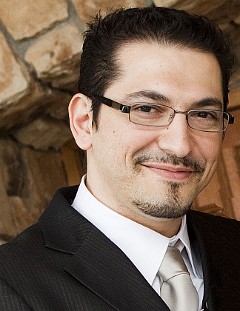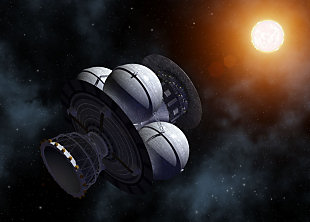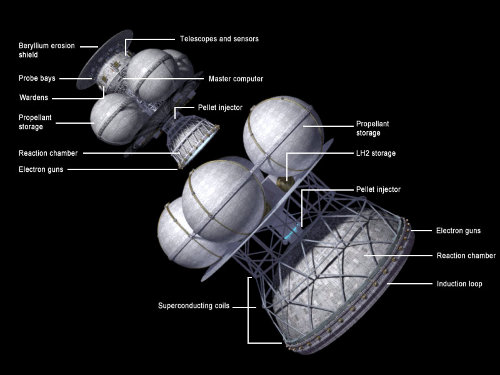by Andreas Tziolas
After a 15 minute main thruster burn early this morning (UTC), the MESSENGER spacecraft is now in orbit around Mercury. Congratulations to the entire MESSENGER team. As we look forward to much more from Mercury, I want to turn today’s session over to Andreas Tziolas, for some thoughts on the mind-bending process of designing an interstellar spacecraft. Dr. Tziolas is a theoretical physicist and spacecraft engineer, currently serving as the Deputy Project Leader of Project Icarus. In his recent PhD (2009), he explored cosmologies resulting from brane collisions in string theory. He is currently the chief scientist for Variance Dynamical, an electronics prototyping company in Anchorage, Alaska developing radiation hardened electronics for use in space exploration. In this article, Dr. Tziolas talks to us about the legend of Icarus and offers some personal reflections from his experience as a part of the inspirational Project Icarus design team.

There have been many projects and collaborations inspired by the dramatic flight of Icarus. A young boy adorns wings made of sticks and wax to soar to the heavens together with his father, Daedalus. As legend would have it, the young boy elated by the sensation of flight decides to push the limits of his father’s creation and, ignoring his warnings, flies higher and higher until the Sun’s radiant beams melt the wax with which his wings were held together and he falls helpless to the ocean, never to be seen again.
The story is quite tragic and brief. There is no need for eloquence in conveying it, nor have I ever searched out the complete telling of the tale. For one I have never felt the need to, perhaps because any retelling would only contradict and confuse its personal meaning to me. I believe it’s a tale of a boy that looked up to his father, an accomplished scientist who managed to fulfill man’s ageless dream of flying. Young Icarus must have grown up carefully observing his parents thinking how one day, he will surpass them, make them proud, go further and higher than they ever could. And so he did.
The tale is then a story of a young man coming of age. In that all important moment of revolt, he disobeys his father and pushes ahead, a man now, flying far above his father, ever climbing higher and higher, tasting freedom and independence as he climbed to touch the Sun. I believe Icarus would have kept on going until he found a new sky, far up and into space where he may have paused to regard the stars before returning to Earth to tell his father all about it.
Pushing Past the Boundaries
Having been part of Project Icarus since its inception, I have come to realize how many of our designers share the spirit of this young boy of legend. We may not all have the genius of our father, Daedalus but we are intent to push the boundaries of science and technology to make a contemporary plausible reference design from which humanity might one day construct the vessel to voyage to the stars. Like so many others, we stand on the shoulder of giants – the inspirational Project Daedalus team, who were the first to piece together the sticks and rope and wax wings – to show us how the seemingly impossible was merely difficult. The British Interplanetary Society has the richest history, amongst all space organizations ever, for supporting those ideas which matter – the ideas which inspire. We are proud to be descended from that same house.
Image: The Project Daedalus design, as developed by the British Interplanetary Society in the 1970’s. Credit: Adrian Mann.
I feel fortunate that my path in life led me to being a part of this project; to have become a physicist, inspired by all those science fiction movies and books and to have made some small contribution to science. I have also seen, with great disappointment, those sometimes more capable than me, move away from that which inspired them – sometimes even looking down with contempt at notions of starships, planetary terraforming and faster-than-light travel. Somewhere along the way that special fire went out, perhaps because it seemed too difficult or science did not yet have the faculty to clearly provide a path towards such accomplishments.
So now a group of volunteers decide to hoist themselves up onto the shoulders of those intellectual giants and take on the most challenging of space endeavors. Designing a starship is difficult business. Managing a team of international volunteers and keeping the project on track is, as it turns out, a fairly interesting story in itself.
Making Icarus Happen
First and foremost, we are all volunteers which means of course we are not being paid for our work. The amazing consensus amongst the team however, is that any contribution we make towards advancing mankind to the stars is sufficient reward. As such we have come to expect the highest quality of scientific work from each other which is ensured through a rigorous internal review process. Trade studies, research notes and papers are first published internally and are subject to the highest level of academic and professional scrutiny.

In this process disagreements are a natural occurrence, the resolution of which is usually orchestrated by the Project Leader (PL), the Deputy Project Leader (DPL) and the Core Design Team, which is comprised of those who have proven their worth to their team through their dedication and quality of work. In other research organizations, conflicts are resolved either by deferring to a higher authority or by an appropriate democratic process and vote. In Project Icarus neither are appropriate, since volunteers can neither be fired, nor disciplined since any work contributed has been done with significant personal investment. The democratic method is also meaningless, since a panel of experts in interstellar engineering would be required, which doesn’t exist anywhere in the world. It would seem that Project Icarus has reinvented an almost forgotten process of conflict resolution, which is done through respect and reason. Discussions are respectfully conducted at all times, the resolution of which relies solely on what is reasonable. These reasonable technical decisions are steering the design process towards a plausible spacecraft design which is essential to establishing our credibility.
And what about motivation? How do you motivate someone to get cracking and study up on the latest antimatter confinement paper, when he or she already works full time and has a family? It is indeed very difficult. Project and Module Leaders must frequently remind designers of deadlines for finishing studies and ask for progress reports. Team performance is tabulated and monitored for studies which are potentially falling behind. Emails to delinquents are written in a strange tone which somehow combines appreciation for work promised and freely offered with the resounding crack of the whip.
Sometimes management is management, even in Project Icarus, but for the most part yet another fascinating phenomenon tends to align the team with our research objectives. You see, everyone on the team is a scientist of sorts. OK, so yes, everyone is one or another sort of geek. Some are computer geeks, others technology geeks, sci-fi geeks, rocketry geeks, etc, etc the list goes on. On occasion designers will come across something loosely related to an Icarus research study topic while reading their favorite geek-blog and email it to the rest of the team. From the commentary that follows, ideas are formulated which are slowly technically justified and extended resulting in our designers getting excited and motivated. An all important side-effect of this process is that the entire team stays informed of the latest scientific developments, beyond the capacity of any one geek.
Growth of the Project
In the last year, Project Icarus has been steadily growing in popularity through our presentations at conferences in Europe and the USA, paper publications and through articles appearing in scientific magazines and notable websites such as the Discovery Channel. I have noticed that every time we appear in the press, the team rejoices and their research efforts are invigorated. In a sense, this exposure justifies the long hours of work that is being poured into the project.

I know for a fact several of our designers are people that have been working on the problem of interstellar flight for many years, training themselves by carefully monitoring technological innovations and scientific articles for small pieces of the puzzle. For most of us, not lucky enough to be working for NASA or a distinguished university with a space research group, we are still left with that feeling of looking in from the window, regardless of how many papers we read on Magnetic Confinement Fusion in our free time. Project Icarus is a home, or a docking station if you will, to all those dedicated thinkers.
Image: Daedalus arrives at its target, Barnard’s Star. Credit: Adrian Mann.
There are certainly many many other organizations inspired by space out there, like the Mars Society for instance, but that’s Bob Zubrin’s dream. Wouldn’t it be nice to join a group of like minded people who like you, are willing to put 5 years of concerted effort into designing a starship or a lunar research station or a space elevator? Sure there are some aspiring companies out there which have worked hard to get funded to do that kind of research, but they don’t have to be the only ones.
In the same way we create our man-caves and mom-caves – our little corners of heaven in our garage where we can work on small but fulfilling microelectronics or woodworking projects, we could also band together, get organized and allow ourselves to become a cog in a great machine that builds dreams out of science. I wonder what the world would look like if we all got up in the morning and went to our regular jobs in our offices and worksites, came home, had some dinner, watched some TV, played with the kids and then sat down in front of the computer to work on the designs of a starship or satellite. This is not the first time someone had this idea, nor am I saying that this is something new. Wikipedia was built from the community and a truly excellent job has been done. Others are now finding ways to motivate what are being called “crowd-sourcing” projects, where the content is built up from users.
The Real Ending of the Icarus Story
Icarus flew towards the Sun and burned his wings and now Project Icarus is designing a starship to fly to a nearby Star. “What an unfortunate choice of name!”, most people tell us. Maybe I watch too many movies, but I don’t believe the legend is complete and that there is more to the tale of Icarus, either lost through the ages or just waiting for ages to be told.
I believe that, like so many heroes that fall off of cliffs and fall into the ocean, Icarus was not lost at sea after his long fall from touching the Sun. Icarus came to on the shore of a Greek beach, exhausted and confused. After searching through the sky for his father for many days and nights, he took pause and collected himself. He started a fire and found he had melted the sand into glass and that the soft clay had become rock. After studying these carefully, he saw the future unfolding and understood his destiny. He meticulously collected materials to slowly build himself a better set of wings made of fabric and steel, working day and night under the hot sun. He did not tire or lose confidence, for he had had the best of teachers, his father Daedalus. And he would not be repeating his mistakes.
If anyone reading this feels motivated, then please feel free to contact Project Icarus. We have a lot of work to be done and we are in need of competent scientists. We believe that everyone brings something new to the project and the least you will get in return is a profound kinship, a thirst for learning and an interstellar starship with a good name.




Much as I love the idea of a probe to the stars, I wonder if we will ever do it.
For one-thousandth the cost of Icarus, we could send a probe to the sun’s gravitational focal point opposite the star and study it that way, getting results in months instead of decades. More pertinent, for one-millionth the cost of Icarus, we could build a hypertelescope and get the results immediately.
After Earth: Why, Where, How, and When We Might Leave Our Home Planet
Humanity may have millennia to find a new home in the universe–or just a few years
By Ben Austen
Posted 03.16.2011 at 9:10 am
http://www.popsci.com/science/article/2011-02/after-earth-why-where-how-and-when-we-might-leave-our-home-planet
I do not think we should wait until humanity is in some kind of crisis to consider interstellar travel. By then it may be too late to do anything.
“I don’t believe the legend is complete and that there is more to the tale of Icarus, either lost through the ages or just waiting for ages to be told.
I believe that, like so many heroes that fall off of cliffs and fall into the ocean, Icarus was not lost at sea after his long fall from touching the Sun. Icarus came to on the shore of a Greek beach, exhausted and confused. After searching through the sky for his father for many days and nights, he took pause and collected himself. He started a fire and found he had melted the sand into glass and that the soft clay had become rock. After studying these carefully, he saw the future unfolding and understood his destiny. He meticulously collected materials to slowly build himself a better set of wings made of fabric and steel, working day and night under the hot sun. He did not tire or lose confidence, for he had had the best of teachers, his father Daedalus. And he would not be repeating his mistakes.”
Rewriting the Icarus myth to fit it to the star ship building goal is somewhat religious in its overtones. Perhaps it would have been better to call the project, Daedalus II to avoid the Icarus connotations.
While paper studies can be useful, and certainly inspiring, ultimately there is a complete misunderstanding of the nature of timing and technological development. By the time we could actually afford to build such a ship as currently designed, scientific and technical knowledge and capabilities, let alone cultural goals, will likely have vastly changed. It is even worse than the Victorians designing the internet with Babbage machines, especially as they wouldn’t even have thought in those terms.
If/when technology and economics allows us to seriously consider interstellar flight, at best, the Icarus designs will look like da Vinci’s drawings of flying machines.
Da Vinci’s flying machines! An excellent model for the Icarus aspiration, and not too shabby a goal to strive for, if you ask me.
Yeah, it might not work. Do what I always do and just give up … Victorians. But Icarus please do elevate our children from this most unbright cinder.
The story rewrite is good for this project and many others because it is about success through excellence. On this island Earth, we keep improving our wings. Face it, we are on our way starward. I’m sure there is a quote, failure is not when you fall, rather it is when you fail to rise up and try again. I mean give over, we got born, we’re going to die…now we’ve got to do something in between, why not something majestic?
Just a moment…Just a moment…whats that smell? Like … burnt….FEATHERS!
What a wonderful name for the project. Do a survey of your friends and I am sure that you will find that very many more have heard of Icarus than of Daedalus. It is Icarus whose name has lived on to inspire billions, not his seemingly more successful father. Here the unlimited aspirant for great success exceeds the more limited successful practitioner.
Few people of great intellect have great intellectual curiosity, and I wish that I could say that that was their problem. Tragically, it is ours also. All we can do is look to the example of Icarus as we hope to drag these people into aiding humanities future.
If we ever do launch interstellar probes, they will likely look more like starseeds than Project Icarus:
http://www.iase.cc/launcher.htm
@Manzanec
Interesting idea. I wonder if it was ever fleshed out or discarded for obvious flaws. Like Starwisp, it would offer one explanation of the Fermi paradox – alien machine presence is just too small to be detected.
@Alex
One obvious flaw is the fact that entities this small cannot survive collisions with the oncoming interstellar medium. This is mentioned in the piece, but not really credibly addressed.
A certain amount of mass is needed to overcome the ISM, and dispersing it into smaller pieces is not really helpful, just the opposite. The ISM between here and Alpha Centauri would form a layer of a few micrometers thick if it were liquefied. In order to survive, a probe must be many times thicker.
@ Mazanec
If we’re interested in life in extrasolar systems, we have to send a vehicle. No Solar-System based telescope will be able to put a microscope to the dirt of an extrasolar planet, or dig below its surface. We need ground truth and on-the-spot analysis, so there’s no substitute for actually being there. Telescopes will give us a first impression and guide the starships. But those ships will need to carry landers which are a lot more capable than Viking or Huygens were!
Stephen
Oxford, UK
Sending probes and landers so far away and having them work flawlessly without any chance of human intervention is a huge challenge, perhaps of comparable difficulty to the propulsion problem. I believe that by the time we can do that, we will also be able to put together a mechanical seed, which upon landing will proceed to mine, process and manufacture to bootstrap itself into a large, self-sufficient facility. Exploration will be second priority, but can then proceed at a rapid pace driven by an (initially) exponentially expanding industrial base. This will add many orders of magnitude to the science return, establish a permanent base, and even set the stage for eventual colonization.